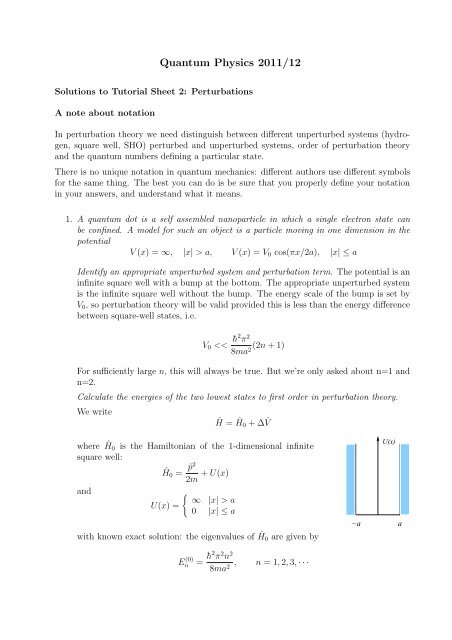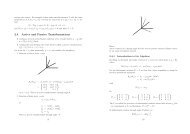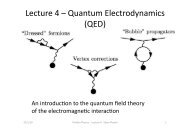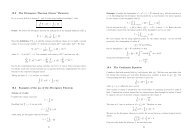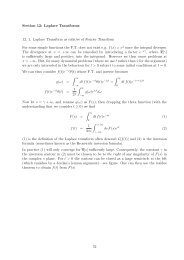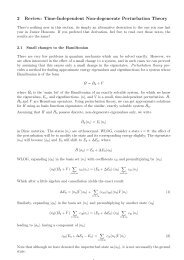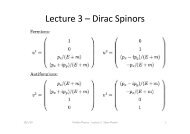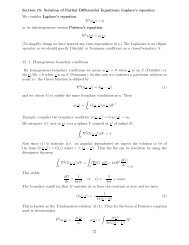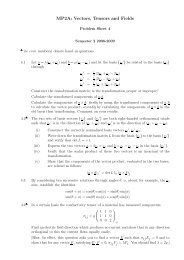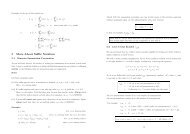Quantum Physics 2011/12
Quantum Physics 2011/12
Quantum Physics 2011/12
- No tags were found...
You also want an ePaper? Increase the reach of your titles
YUMPU automatically turns print PDFs into web optimized ePapers that Google loves.
<strong>Quantum</strong> <strong>Physics</strong> <strong>2011</strong>/<strong>12</strong>Solutions to Tutorial Sheet 2: PerturbationsA note about notationIn perturbation theory we need distinguish between different unperturbed systems (hydrogen,square well, SHO) perturbed and unperturbed systems, order of perturbation theoryand the quantum numbers defining a particular state.There is no unique notation in quantum mechanics: different authors use different symbolsfor the same thing. The best you can do is be sure that you properly define your notationin your answers, and understand what it means.1. A quantum dot is a self assembled nanoparticle in which a single electron state canbe confined. A model for such an object is a particle moving in one dimension in thepotentialV (x) = ∞, |x| > a, V (x) = V 0 cos(πx/2a), |x| ≤ aIdentify an appropriate unperturbed system and perturbation term. The potential is aninfinite square well with a bump at the bottom. The appropriate unperturbed systemis the infinite square well without the bump. The energy scale of the bump is set byV 0 , so perturbation theory will be valid provided this is less than the energy differencebetween square-well states, i.e.V 0 aU(x) =0 |x| ≤ awith known exact solution: the eigenvalues of Ĥ0 are given byE (0)n = ¯h2 π 2 n 2, n = 1, 2, 3, · · ·8ma2 −aU(x)a
and the corresponding eigenfunctions areu n (x) = 1 √ a{cossin} (nπx2a) {n oddn evenThe perturbation is∆ ˆV = V 0 cos( ) πx2a|x| ≤ aand to first order in perturbation theory, the energy shifts aregiven by∆E n = 〈u n |∆ ˆV |u n 〉 =∫ a−au ∗ n(x)∆ ˆV u n (x) dx−aU(x)+H’(x)aFor the ground state:∆E 1 = V 0a= 2V 0π= 2V 0π= 2V 0π∫ acos−a∫ +π/2−π/2∫ +1−1( ) πxcos2a( ) πxcos2a( ) πxdx = V ∫ a02a a −a( ) πxcos 3 2acos 3 θ dθ where θ ≡ πx2a(1 − sin 2 θ ) d(sin θ) using the identity cos 2 θ ≡ 1 − sin 2 θ[sin θ − 1 3 sin3 θ] +1−1dxThus∆E 1 = 8V 03πSimilarly for the first excited state (n = 2):∆E 2 = V 0a= 2V 0π= 8V 0π= 8V 0π= 8V 0π∫ a( ) πxsin cosa−a∫ +π/2−π/2∫ +π/2−π/2∫ +1−1( ) πxsin2asin 2 2θ cos θ dθsin 2 θ cos 3 θ dθsin 2 θ ( 1 − sin 2 θ ) d(sin θ)[ 13 sin3 θ − 1 5 sin5 θ] +1−1( ) πxdxawhere θ ≡ πx2ausing the identity sin 2θ ≡ 2 sin θ cos θThus∆E 2 = 32V 015πWhat is the sign of V 0 ?
Since the electron is attracted to the atoms comprising the dot, it is likely to be morestrongly bound at the centre. Hence V 0 will be negative.State two ways in which the colour of a material containing dots can be shifted towardsthe red.To vary the colour, we need to change the difference between energy levels. The simplestway to do this is to use a larger dot, increasing a in the unperturbed energiesand hence reducing (redshifting) their energy. Alternately, we just saw that the perturbationlowered the ground state by more than the excited state: thus a smaller V 0(i.e. a material which less strongly bound the electron) would give a red shift.2. A particle moves in one dimension in the potentialV (x) = ∞, |x| > a, V (x) = V 0 sin(πx/a), |x| ≤ a• show that the first order energy shift is zero;Just as in the previous question, we writeĤ = Ĥ0 + ∆ ˆVwhere Ĥ0 is the Hamiltonian of the 1-dimensional infinite square well.The first order formula for the energy shift is then∆E n = 〈n|∆ ˆV |n〉 =∫ a−au ∗ n(x)∆ ˆV u n (x) dxThus∆E n = V 0a∫ a−a{cossin} (nπx )2a· sin( ) πxa·{cossin} (nπx )2adx{n oddn evenWe observe that the integrand is always an odd function of x regardless of the valueof n, and hence the integral from −a to a must vanish. Hence∆E n ≡ 0• * obtain an expression for the second order correction to the energy of the groundstate.At second order, the correction to the ground-state energy is given byFor m odd:〈m|∆ ˆV |1〉 = V 0a∆E (2)1 = ∑ m≠1∫ a−acos( ) mπx2abecause the integrand is an odd function of x.|〈m|∆ ˆV |1〉| 2((0) E 1 − E m(0) )sin( ) πxacos( ) πx2adx ≡ 0
For m even, no such argument applies and we have to work hard to evaluate therequired integral!〈m|∆ ˆV |1〉 = V 0a= 2V 0π= 4V 0π∫ a( ) mπxsin sin2a−a∫ +π/2−π/2∫ π/20( ) πxacossin mθ sin 2θ cos θ dθsin mθ sin 2θ cos θ dθ( ) πx2aWe now use the trigonometric identities (from cos A cos B etc.) :to write〈m|∆ ˆV |1〉 = V 0π= V 0πdxwhere θ ≡ πx2asin mθ sin 2θ ≡ 1 [cos(m − 2)θ − cos(m + 2)θ]2cos(m − 2)θ cos θ ≡ 1 [cos(m − 1)θ + cos(m − 3)θ]2cos(m + 2)θ cos θ ≡ 1 [cos(m + 3)θ + cos(m + 1)θ]2∫ π/20[cos(m − 1)θ + cos(m − 3)θ − cos(m + 3)θ − cos(m + 1)θ] dθ[ sin(m − 1)π/2+(m − 1)Recall that m is even and ≥ 2 so thatsin(m − 3)π/2(m − 3)−sin(m + 3)π/2(m + 3)sin(m − 1)π/2 = sin(m + 3)π/2 = (−1) m 2 +1sin(m − 3)π/2 = sin(m + 1)π/2 = (−1) m 2−sin(m + 1)π/2(m + 1)]Thus〈m|∆ ˆV |1〉 = (−1) m/2 V 0π[− 1](m − 1) + 1(m − 3) + 1(m + 3) − 1(m + 1)Putting everything over a common denominator yields〈m|∆ ˆV |1〉 = (−1) m/2 V 0π16m(m 2 − 9)(m 2 − 1)Thus〈2|∆ ˆV |1〉 = 32V 015π ; 〈4|∆ ˆV |1〉 = 64V 0105πNow for the unperturbed Hamiltonianetc(E 1 − E 2 ) = π2¯h 22(1 − 4) = −3π2¯h8ma2 8ma 2and so we find that the second order energy shift is an infinite sum of the even mterms, changing the index so that n = 2m ...
∆E (2)1 = ∑ n(V0π) 2n.2(n 2 − 36)(n 2 − 4)8ma 2(1 − 4n 2 )π 2¯h 2Noting that this ultimately scales as n −9 , we can assume that the sum converges, andwe already saw that the first order term is about four times the second.( ) 2∆E (2) 32V0 8ma 21 = −15π 3π 2¯h 2 + . . .3. The 1-d anharmonic oscillator: a particle of mass m is described by the HamiltonianĤ = ˆp22m + 1 2 mω2 ˆx 2 + γˆx 4• Assuming that γ is small, use first-order perturbation theory to calculate theground state energy;• * show more generally that the energy eigenvalues are approximately( ) 2¯hE n ≃ (n + 1)¯hω + 3γ (2n 2 + 2n + 1)22mωHint: to evaluate matrix elements of powers of ˆx, write ˆx in terms of the harmonicoscillator raising and lowering operators â and â † . Recall that the raising and loweringoperators are defined byâ ≡√ mω2¯h ˆx + i√ ˆp and â † ≡2mω¯h√ mω2¯h ˆx − i√ ˆp 2mω¯hwith the properties thatâ|n〉 = √ n |n − 1〉 and â † |n〉 = √ n + 1 |n + 1〉Since the unperturbed energy eigenstates are non-degenerate, we can use the standardresult to calculate the first order energy level shifts:∆E n = 〈n|∆ ˆV |n〉 = γ〈n|ˆx 4 |n〉The integral associated with the ground state is then√ mω∫γπ¯hx 4 exp (−mωx 2 /¯h) dxWhich is deeply unpleasant. You can look it up:∫ ∞−∞x 2n exp (−ax 2 ) dx = <strong>12</strong> n+1 √ π2n−1 ∏a 2n+1j=1(2j − 1)
so√ mω∫γπ¯hx 4 exp (−mωx 2 /¯h) dx = 3γ( ¯h) 22mωBut to do it yourself, its best to use raising and lowering operators.The unperturbed energy eigenstates satisfyĤ 0 |n〉 = E n |n〉 with E n = ( n + 1 2)¯hω, n = 0, 1, 2, . . .We can write ˆx in terms of â and â † :√¯h (âˆx =)+ â†2mωThus∆E n = γ( ) 2¯h〈n| ( â + â †) 4|n〉2mωExpanding the bracket ( â + â †) 4looks pretty awful until you realise that, from theraising and lowering properties and the orthonormality of the energy eigenstates, onlyterms which contain an equal number of raising and lowering operators will give anon-zero contribution to the diagonal matrix element 〈n|∆ ˆV |n〉. Thus∆E n = γ( ) 2¯h〈n| ( â 2 â †2 + ââ † ââ † + ââ † â † â + â † âââ † + â † ââ † â + â †2 â 2) |n〉2mωFor the ground state, n = 0, this simplifies even further because â|0〉 = 0, so the third,fifth and sixth terms all give zero. Evaluating the remaining three terms,Thusâ 2 â †2 |0〉 = â 2 â † |1〉 = √ 2 â 2 |2〉 = √ 2 √ 2 â|1〉 = 2|0〉ââ † ââ † |0〉 = ââ † â|1〉 = ââ † |0〉 = â|1〉 = |0〉â † âââ † |0〉 = â † ââ|1〉 = â † â|0〉 = 0∆E 0 = 3γ( ) 2 ( ) 2¯h¯h〈0|0〉 = 3γ2mω2mωFor the general case, we have to work a little harder;â 2 â †2 |n〉 = √ n + 1 â 2 â † |n + 1〉 =√(n + 1)(n + 2) â 2 |n + 2〉= √ n + 1 (n + 2)â|n + 1〉 = (n + 1)(n + 2)|n〉ââ † ââ † |n〉 = √ n + 1 ââ † â|n + 1〉 = (n + 1) ââ † |n〉 = (n + 1) √ n + 1 â|n + 1〉= (n + 1) 2 |n〉â † âââ † |n〉 = √ n + 1 â † ââ|n + 1〉 = (n + 1)â † â|n〉 = (n + 1) √ n â † |n〉= n(n + 1)|n〉
ut we also need to consider the previously neglected terms:ââ † â † â|n〉 = √ n ââ † â † |n − 1〉 = nââ † |n〉 = n √ n + 1 â|n + 1〉= n(n + 1)|n〉â † ââ † â|n〉 = √ n â † ââ † |n − 1〉 = nâ † â|n〉 = n √ n â † |n − 1〉= n 2 |n〉â †2 â 2 |n〉 = √ n â †2 â|n − 1〉 =Collecting up terms:= n(n − 1)|n〉√n(n − 1) â †2 |n − 2〉 = (n − 1) √ n â † |n − 1〉(n + 1)(n + 2) + (n + 1) 2 + 2n(n + 1) + n 2 + n(n − 1) = 6n 2 + 6n + 3so that the shift in energy to first order is∆E n= 3γ( ) 2¯h (2n 2 + 2n + 1 ) ( ) 2¯h (〈n|n〉 = 3γ 2n 2 + 2n + 1 )2mω2mωAs a check, putting n = 0 reproduces the ground-state shift we obtained above.4. A 1-dimensional harmonic oscillator of mass m carries an electric charge, q. A weak,uniform, static electric field of magnitude E is applied in the x-direction. Show that,to first order in perturbation theory, the oscillator energy levels are unchanged, andcalculate the second-order shift. Can you show that the second-order result is in factexact?Hint: to evaluate matrix elements of ˆx, write ˆx in terms of the harmonic oscillatorraising and lowering operators â and â † and use the results â|n〉 = √ n|n − 1〉 andâ † |n〉 = √ n + 1|n + 1〉.The perturbation is just the potential energy of a particle of charge q in a constantelectric field of magnitude E:∆ ˆV = −qE ˆxso that to lowest order, the energy shift of the nth level is∆E n = −qE〈n|ˆx|n〉 = −qE∫ ∞−∞u ∗ n(x) x u n (x) dx ≡ 0since the integrand is an odd function of x. So to lowest order, the energy levels areunchanged.At second order, the shift is given by∆E (2)n= ∑ m≠n|V mn | 2E n (0) − E m(0)= ∑ (−qE) 2 |〈m|ˆx|n〉|2m≠n¯hω(n − m)Now the matrix element can be written in terms of matrix elements of â and â † using√¯h (âˆx =)+ â†2mω
Thus√¯h〈m|ˆx|n〉 =2mω 〈m| ( √â + â †) ¯h [√|n〉 = n δm,n−1 + √ ]n + 1 δ m,n+<strong>12</strong>mωwhich tells us that only the terms with m = n ± 1 contribute to the sum. Pluggingthis result in we find that∆E n (2) = q2 E 2 [ ]¯h n (n + 1)+ = − q2 E 2¯hω 2mω 1 −1 2mω 2To see that this is actually the exact solution, we note that the full Hamiltonian canbe writtenĤ = − ¯h2 d 22m dx + 1 2 2 mω2 x 2 − qE xWe introduce a new variableξ ≡ x − qEmω 2Noting thatξ 2 = x 2 − 2qEmω x + q2 E 22 m 2 ω 4we see that the Hamiltonian can be rewritten asd 2Ĥ = − ¯h22m dξ + 1 2 2 mω2 ξ 2 − q2 E 22mω 2and thus the energy of the n th state of the full Hamiltonian has energy eigenvalues.E n = (n + 1 2 )¯hω − q2 E 22mω 2which just differs from the usual 1-d oscillator Hamiltonian by a constant shift. Notethat each energy level in the perturbed state corresponds to a level in the unperturbedstate, so the quantum number n can still be used to label them.5. Starting from the relativistic expression for the total energy of a single particle, E =(m 2 c 4 +p 2 c 2 ) 1/2 , and expanding in powers of p 2 , obtain the leading relativistic correctionto the kinetic energy.For a single relativistic particle[ ] 1/2E = (m 2 c 4 + p 2 c 2 ) 1/2 = mc 2 1 + p2m 2 c 2[= mc 2 1 + p22m 2 c + 1 ( ) ( ) ]1 −1 p42 2! 2 2 m 4 c + . . . 4= mc 2 + p22m −p48m 3 c + · · · 2Recalling that in special relativity, the kinetic energy is defined to be the differencebetween the total energy and the rest energy, gives the desired result:T ≡ E − mc 2 = p22m −p48m 3 c + . . . 2
for a plane wavefunction Φ(x) = A cos(kx), and determine whether Φ(x) is an eigenstatefor a relativistic free particle.Taking ∆T = − p48m 3 c 2 = − ¯h4 ∇ 48m 3 c 2 , We need to evaluate:∫Φ(x)∆ ˆT∫Φ(x)dx = − A 2 ¯h 4 d 4cos(kx) cos(kx) dx8m 3 c 2 dx4 ∫= A 2 ¯h4 k 48m 3 c 2 cos2 (kx) dxThe normalisation is straightforward:∫A 2 =cos 2 (kx) dxThus for a normalised particle, the integrals cancel and we have:Meanwhile, using the aboveˆT A cos(kx) =∆T = − ¯h4 k 48m 3 c 2(¯h 2 k 22m − ¯h4 k 48m 3 c 2 )A cos(kx)Hence cos(kx) is still an eigenstate for a free particle, with energyE k = ¯h2 k 22m − ¯h4 k 48m 3 c 2


